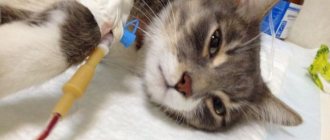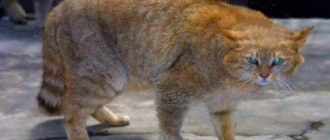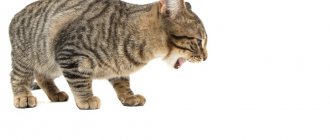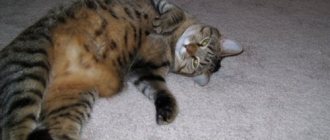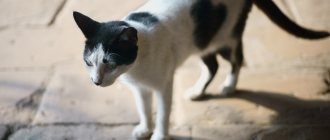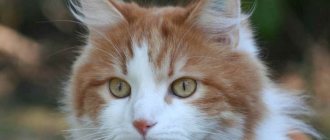When a pet's health fails, owners do not always show concern when trying to treat the animal at home. If your cat's hind legs begin to fail, this is a reason to immediately contact a veterinarian.
The reason for limb failure may be a serious illness or injury that requires immediate treatment. Slowness can be fatal. Any gait disturbances, paralysis, or spinal injuries in an animal cannot be cured on your own.
Failure to contact a veterinarian in a timely manner greatly increases the risk of complete loss of sensitivity and mobility of the paws.
So, the cat’s hind legs are failing, causes, signs, treatment, prognosis.
Hind paw failure: the most common causes
Loss of limb mobility can occur for a variety of reasons. It is extremely difficult for an animal owner to make a diagnosis on his own; a trip to a veterinary clinic will help to adequately assess the condition of a sick cat, completely cure and restore the pet.
- Spinal column injuries.
The hind limbs lose mobility due to spinal injuries. Particular attention should be paid to the lumbar region. A cat walking on the streets can get injured.
The spine can be damaged when hit by a car, bicycle, motorcycle, or falling from a tree or fence. Cats living at home can also injure their spinal column by falling from a ledge or cabinet. Symptoms: the pet drags its back, the tail is motionless, the cat feels weak.
- Thrombus in the femoral artery.
When the femoral artery is blocked (thromboembolism), the pet gradually loses sensitivity in the limbs, the cat suffers from severe pain in the lumbar region, screams, and tries to bite the lower back. Tissue necrosis that accompanies the blockage process leads to complete failure of the hind legs.
Timely therapy provided to the pet in the first hours can lead to complete recovery of the body. Inaction on the part of the owner will result in the painful death of the animal in 3-4 days.
- Tick bite.
Be sure to read:
Gingivitis in cats: how to recognize and treat the disease
An ixodid tick bite leads to paralysis and subsequent death. The pathological condition is as follows: after the bite, the cat becomes excited, later the animal begins to feel severe weakness, apathy, continuous trembling spreads throughout the body, and paralysis begins.
Therapy should begin when the pet is excited, otherwise it will be too late.
- Myelitis.
Myelitis (inflammation of the spinal fluid) can develop as a result of infectious diseases, worms, poisoning with harmful substances, or injury.
The pathology is accompanied by the following symptoms: loss of paw mobility, chaotic movements, elevated body temperature, vomiting, diarrhea, involuntary urination. Timely therapy will lead to complete restoration of sensitivity.
- Pathology of the hip joint.
With hip dysplasia, the correct formation of bone tissue is disrupted. Large breed cats are susceptible to the disease.
The pathology causes severe pain when walking, it is difficult for the cat to jump, and the gait changes over time. Without supportive care, the disease can lead to hind leg failure.
- Stroke.
Motor activity may disappear due to a stroke. Blood clots can be present in both an elderly pet and a young pet due to poor diet and sedentary lifestyle.
Blockage of blood vessels in the brain leads to paralysis of the limbs. The sooner the pet owner notices the attack and begins treatment, the greater the chance of a full recovery.
- Heart failure.
Improper heart function can lead to loss of paw mobility. A diseased organ does not provide the required amount of oxygen to the body, resulting in muscle atrophy. Associated symptoms: the appearance of shortness of breath, dry cough, lethargy.
Main predisposing factors
First, the most obvious cause is injury. If a cat injures its back during the “March festivities” or ordinary fights with its relatives, the consequences can be extremely sad. Moreover (as is the case with people, by the way) they often do not appear immediately, but after several months, or even years. The problem is that with strong impacts:
- Compression fractures of the spine are possible. Or cracks, which happens more often.
- Such injuries are one of the main reasons for the development of intervertebral hernias in the future.
- It is also possible that the vertebrae may be displaced relative to their normal position.
Why is everything described so dangerous, what are the reasons for weakness? The fact is that the vertebrae, when put together, form the spinal canal. It contains the spinal cord. In addition, there are special openings directly between the vertebrae that are necessary for the passage of the spinal cord roots. They are necessary for the innervation of internal organs, limbs, etc.
When the spine experiences critically strong loads that can lead to the formation of cracks or displacement of the vertebrae, fragments or edges of bones can compress or even tear the spinal roots. In this case, the innervation suffers greatly, and sometimes stops altogether. As a result, not only banal weakness of the hind limbs, but also complete paralysis. In addition, injuries often manifest themselves in the form of ataxia, that is, poor coordination of movements. So in all cases when you see signs of a “good” fight on your pet, take the time to take him to the vet. This can save you from many problems in the future. The treatment in all of the above cases is the same – surgery.
Wounds and injuries
Back wounds are no less dangerous. Why? It's simple - all wounds have an unpleasant “habit” of suppuration and inflammation. Simply put, pathogenic or conditionally pathogenic microflora begins to develop in their canal. It’s not at all good when pyogenic microorganisms get into the wound. And pus, by the way, is a very strong “solvent.” It has a lysing effect. It is associated with the release of a huge amount of enzymes by the bodies of dead leukocytes and the microbes themselves. It is not difficult to guess what happens when such a wound (or abscess) is located close to the spine. When the volume of pus reaches critical levels, all this can easily get into the spinal canal or, at least, melt the spinal roots.
All this leads to a similar effect - weakness of the hind legs (at best) or complete paralysis and further death from sepsis, myelitis and meningitis (which is much more common). What to do? Take your pet to the clinic immediately. There he will be prescribed adequate therapy. As a rule, a combination of surgical excision of the affected tissue and the administration of loading doses of antimicrobial drugs is practiced.
Hip dysplasia
An extremely dangerous and completely unpredictable pathology. In the case of this disease, the cat's hip joints begin to deteriorate. The disease is rarely diagnosed in young and relatively young animals (but this is not at all excluded). But old cats are susceptible to it, of course, not all of them, but the pathology is really common in them.
It all starts out very harmlessly. At first, the pet begins to stumble out of the blue, and sometimes its legs get tangled. “Attacks” are fleeting and pass very quickly, which is why the owners do not have any suspicions until a certain time. But they arise quickly and develop even faster into panic when the cat stops getting up and “drives up” to the bowl with his favorite food, pulling himself up on his front paws. When you try to probe his joints, he screams hoarsely and tries to bite the “tormentor”. The animal is in a lot of pain, which is why this behavior occurs.
How to deal with the disease? In mild cases, the administration of lethal doses of anti-inflammatory corticosteroids helps. There are two problems here. Firstly, they cannot be used for a long time, as this is fraught with serious side effects. Secondly, there is no talk of any recovery here - medications only slow down the development of the disease, but nothing more. So in these cases, weakness in the hind legs is treated radically - it is necessary to replace the destroyed joints with artificial implants. The operation is very expensive, but it is the only thing that can give your cat a chance at a normal life.
Arthritis and arthrosis
These are also very common pathologies that have much in common with the disease described above. As in the previous case, degenerative-inflammatory processes develop in the joint, which leads to its gradual destruction. And the consequences include not only poor paw function in an old cat. In arthritis, the synovial cartilage of the joint capsules is destroyed. In severe cases, the surfaces of the bones begin to rub against each other, “dry”. This causes such severe pain that the pet tries not to make any movements at all. Fortunately, these pathologies are typical specifically for older pets.
What to do to alleviate their condition? As a rule, therapy is symptomatic. The animal is prescribed anti-inflammatory corticosteroids and antimicrobial agents (if there is a suspicion of a bacterial nature of the disease). To prevent your pet from being in so much pain, it is necessary to administer sedatives. Unfortunately, severe cases are treated exclusively by surgery.
Signs of limb failure
Symptoms to pay close attention to:
- Complete or partial impairment of motor function. The cat stops moving quickly, drags its limbs, and moves by crawling.
- Changes in gait. “Wobbling” of a small kitten is a normal phenomenon; a similar situation with an adult animal should alert the owner.
- Amyotrophy . Muscles lose elasticity.
- Pain on palpation of the hind limbs. The animal screams in pain if the back of its body is touched.
- Lack of sensitivity. The animal stops feeling heat and cold with its paws.
Be sure to read:
The cat has a stomach ache: causes, symptoms, what to do, whether it needs to be treated, what not to do
A 15-year-old cat suddenly lost her paws.
Good afternoon Persian cat, 15 years old, yesterday morning her hind legs suddenly gave out, without pain. A month ago, due to carelessness, she ate fatty kitten food and began severely vomiting and refusing to eat or drink. An ultrasound showed an enlarged liver, all tests (general and biochemistry/liver tests) were normal. We spent 2 weeks on Heptral drips, began to eat, drink, wash again, lead almost the same lifestyle, and began to move less. There were problems with stool, stagnation of feces. They gave me Vaseline oil once, but then my stools were irregular, small and dry. Yesterday at about 11 am she came, climbed into bed on the wide windowsill, slept there for about 40 minutes under supervision, calmly, relaxed. When I tried to get off, I saw that my hind legs were not listening and were braided. I put the cat on the floor and she tried to walk, got tangled in her paws, sat down on the floor and began to crawl. She was calm, there was no pain, while I was getting ready for the clinic, she crawled into the kitchen to have a snack. The clinic did an x-ray - there were no fractures/damages. Large stagnation of feces. The sensitivity of the paws was impaired, the hind paws became cooler to the touch, the muscles were soft. They prescribed injections for 5 days: - spinal block: ceftriaxone, dexamethasone, novocaine - traumatin - cerebrolysin - spasmolgon - vefazal - actovegin Plus vaseline oil to ease the intestines. We spent about 2 hours in the clinic, by which time the cat was mewing quite loudly, acting restless, and possibly feeling pain. We returned home, she continued to behave restlessly, tried to crawl into the tray, eventually urinated and calmed down. Vaseline oil had no effect yesterday. My appetite remained excellent, the rest of the time I slept, quite relaxed, my breathing was even. It was clearly visible how she stretched in her sleep and slightly moved her hind legs (bending/unbending); her tail also retained mobility. At night I also slept peacefully, in the morning we went to the clinic again, gave injections, poured Vaseline oil in front and behind, but 8 hours have passed - there is no effect (tomorrow we will do an enema), she sleeps, ate 2 times. He responds to voices, his eyes are clear, when you pick him up, he relaxes and begins to purr, in general he behaves as usual, only his back legs don’t walk ((I ask for advice on what happened, what are the possible prognoses, how adequate is the treatment. Thank you in advance.
Treatment
When the pet is brought to the veterinary clinic, the doctor:
- conducts an initial examination, determines the degree of sensitivity of the paws;
- prescribes an x-ray examination;
- conducts ultrasound of internal organs;
- takes the animal's blood and urine for analysis.
Treatment is prescribed after diagnosing the disease; therapy includes: medication, physiotherapy, paw massage, and in rare cases, surgery.
Diagnosis of the disease
To determine the cause of the pathological process, the following laboratory tests are prescribed:
- general clinical analysis of blood and urine;
- blood biochemistry;
- bacteriological culture of blood, urine, cerebrospinal fluid;
- ELISA, PCR studies to determine the virus;
- blood test for microelement and vitamin composition.
Based on the symptoms that appear, the doctor prescribes any of these instrumental examinations;
- x-ray of bones;
- Ultrasound of the abdominal organs;
- CT, MRI to determine the structure of the brain and torso layer by layer;
- measurement of intracranial pressure;
- contrast study of blood vessels:
- Ultrasound of the heart, blood pressure measurement.
If the limbs fail and the animal is unable to stand or sit down, an X-ray is a mandatory examination.
Physiotherapy for cats with leg paralysis
The recovery period after paralysis drags on for a long time; in this case, the animal owner cannot do without physiotherapy.
Veterinarians advise performing a daily set of exercises to help restore neurological functions.
- Passive movements. Place the cat on its back and move the paralyzed legs alternately in a circular motion for at least five minutes. The exercise is similar to riding a bicycle.
- Stimulating massage. Stretch your paw pads and limbs daily.
- Scratching. Scratch the paralyzed animal in different places; even with little progress, the cat will try to scratch with its hind paw.
- Using an inflatable ball. Place the cat on its stomach on the ball, so that its paws lightly touch the floor. Roll the ball while holding your pet back and forth.
- Using support. Pass a wide strip of fabric under your pet's belly and try to walk with the animal, holding the ends of the fabric.
- Moving limbs. Take the cat by the hind legs and slowly move them, imitating walking.
- Swimming. Make the cat swim in the bath every day, holding the animal so that it does not choke.
Be sure to read:
Interpretation of blood tests in cats: features of the procedure, types, main indicators, norms
Symptoms of vomiting
Many owners confuse the symptoms of vomiting with coughing, thinking that their pet vomited due to a severe cough. But it is cough that is a symptom of vomiting, and not vice versa. A normal attack of vomiting has several stages:
- The cat feels nauseous, shows anxiety, moves from place to place, licks itself, makes swallowing movements, and salivates profusely.
- The animal begins to cough, stretches its head forward, and breathes deeply and frequently.
- Contractions occur in the abdomen and throat, vomiting occurs, often at first sterile, and then with contents.
At first the cat feels nauseous, gets restless and licks its lips, and an attentive owner may already notice at this stage that the pet will soon vomit
Providing first aid for a concussion in a pet
If the cat received a blow to the head area and there is a suspicion that she has a concussion, then you need to bring her into a room with dim lights and put her down. If the symptoms do not disappear within ten minutes, then you should definitely seek advice from a specialist. Large cities usually have a 24-hour veterinary clinic.
In case of loss of consciousness, you must follow the following algorithm:
- do not try to stir up the animal or lay it on its side;
- in case of tongue retraction, ensure its straightening;
- Apply dry cold to the injury site;
- make a cold compress on the head (wet a towel in cold water, fold it several times and place it on the animal’s head);
- if there is an open wound, you need to stop the bleeding and apply a bandage;
- if vomiting begins, make sure that the cat does not choke on the mass;
- in case of cessation of breathing, it is recommended to perform indirect cardiac massage and artificial respiration.
Among the drugs that can be used without consulting a doctor, use an injection of caffeine and camphor. But it’s better not to treat a cat’s concussion on your own. The symptoms should prompt you to see a specialist.
